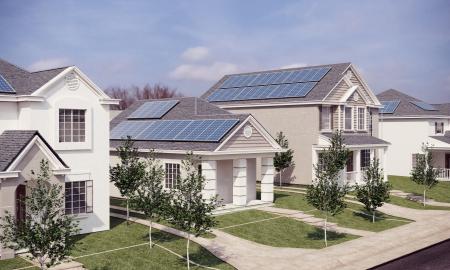Mitigation: Land Use & Housing
CC Goals - Mitigation: Land Use & Housing
Land use and housing development patterns impact GHG emissions in Colorado through both transportation and building energy usage. The closer Colorado residents live to jobs and services, the less distance they have to drive, decreasing vehicle miles traveled – and cutting GHG emissions. Housing located near both transit and high-quality pedestrian and bicycle infrastructure also allows Colorado residents to get where they need to go without driving. In addition, smaller housing units and attached housing units use significantly less energy for heating and cooling, reducing GHG emissions associated with the generation of electricity and the combustion of natural gas. More energy efficient buildings, whether through new construction or by energy efficiency retrofits to existing buildings, further reduce climate-harming building energy use – and also cut consumer costs. Beyond that, robust urban green spaces mitigate climate change by sequestering carbon, and make cities more resilient to the impacts of climate change by providing urban cooling and decreasing flood risk.
State of Colorado Land Use & Housing – Goals & Actions
The State is aiming to reduce GHG emissions from land use and housing to mitigate climate-related impacts by:
- Encouraging compact residential and mixed-use development near jobs and services, and in areas with robust transit, pedestrian, and bicycle infrastructure.
- Incentivizing energy efficiency in buildings, including in buildings used for affordable housing.
- Conserving and expanding urban green spaces to sequester carbon, provide urban cooling, decrease flood risks, and provide multiple health benefits.
Key Priorities
Goals:
- Update land use policies across municipalities and counties to reflect best practices by providing technical assistance and planning grants to local municipalities.
- Expand statewide transit and rail services by increasing mobility hubs, Bus Rapid Transit corridors, Bustang trip frequency, and Bustang ridership.
- Incentivize the creation of new housing units by launching innovative housing programs through Prop 123 Program Implementation.
- Identify land use planning and incentives as a key strategy to reducing vehicle miles traveled and associated GHG emissions reductions. As Governor Polis said in his 2023 State of the State address: “Housing policy is climate policy.”
Actions:
- Passed a law in 2021 that created three new programs offering grant money and other forms of state assistance to local governments to promote innovative solutions to supporting sustainable land use patterns and the development of affordable housing across the state.
- Set guidelines and funding opportunities through the Strong Communities program to provide grants to local governments for physical infrastructure and to support the adoption of land use policies and strategies that support compact development within cities (known as infill), housing affordability, greenhouse gas emissions reductions, and increased public and business health.
- Through the 2022 Land Use Research Report, the state identified common challenges with existing land use patterns, common land use and housing goals shared by Colorado communities, and potential land use strategies to encourage infill development, discourage suburban sprawl, and create smart housing development. The report also summarized the benefits of such policies, including GHG emissions reductions, increased housing affordability, water and land conservation, and reduced wildfire risk.
Goals:
- Ensure that households in disproportionately impacted communities are equitably served.
- Consolidate opportunities for disproportionately impacted communities to participate in home and business upgrade programs, such as rebates, funding, technical assistance, and financing.
Actions:
- Participate in the development of the Colorado Housing Finance Authority’s Multifamily Electrification HUB for Affordable Housing.
- Convene local government representatives to facilitate sharing of best practices for obtaining funding for electrification and efficiency in existing buildings.
- Deploy the Innovative Housing Incentive Program and support the manufacturers of innovative housing, including modular, kit, and 3D-printed homes.
- Advocate for minimum standards for developers receiving state funding for sustainable, efficient affordable housing – for example, under Prop 123 and the Affordable Housing Revolving Loan Fund.
- Support the development of financing structures for low- and medium-income households (on-bill, gap financing, interest rate buy down) – for example, through the Colorado Clean Energy Fund.
Goals:
- Expand and maintain urban green spaces such as parks, gardens, street trees, trails, and green roofs to help capture and store carbon.
- Increase the shade tree canopy to reduce energy use and health risks from heat.
- Reduce water requirements for grass and gardens, decrease flooding risks, and filter stormwater.
- Promote equitable community development, improve climate resilience, and enhance public health and safety.
- Ensure that households in disproportionately impacted communities are equitably served.
- Leverage health co-benefits associated with access to green space including increased physical activity, reduced stress and anxiety, and supported social connectedness.
Actions:
- Supporting community engagement in processes to identify goals and priority areas of need for improving existing and developing future urban green spaces.
- Protecting and conserving urban forests and other green spaces through Revitalizing Main Streets and other programs. Studying and recommending best practices for the management of urban green spaces in cities and towns.
- Investing in creating career opportunities that contribute to the maintenance and enhancement of urban green spaces, such as apprenticeships for arborists.
- Increasing access to urban green spaces through safe and accessible trails and multi-modal transportation routes.

